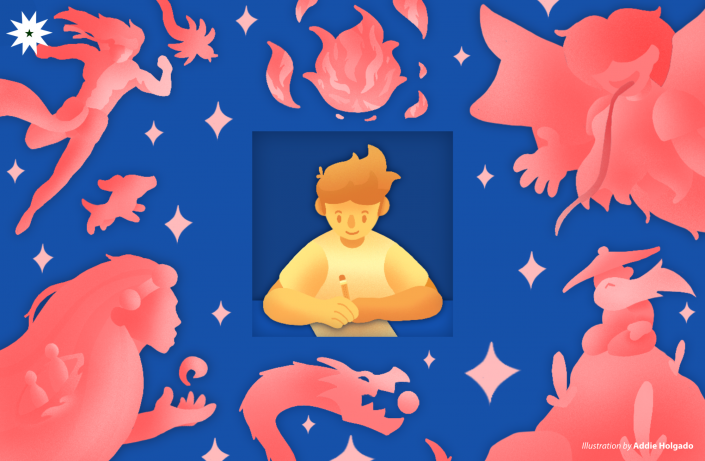
The creaking of the floorboards. A warning against going out into the woods at night. The urge to offer a “tabi-tabi po” as you pass by a mound of dirt. The balete tree you always avoid. These stories have been planted deep in the Filipino psyche, holding an unnerving power that compels us beyond reason. We are endlessly fascinated by the things that go bump in the night and the tales woven with mystique because they allude to a world vastly different from the one we live in now. This yearning for the otherworldly is tangible in the hushed tones around the campfire as a spooky story is shared, in the way our parents’ bedtime stories carry us to sleep, in the thrill we get from the movies we see.
(Excuse me, just passing through.)
Steeped in history and shaped by culture, folklore is more than just a mere collection of old wives’ tales. These stories are sometimes remnants of pre-colonial civilizations, surviving the ravages of time. Although much has been erased of our culture then, folklore is being reborn in the form of modern media—reeling in both local and international audiences. With artists like Budjette Tan and Jap Mikel seamlessly integrating Filipino folklore in their works, it proves that nothing is ever truly lost.
Modern tales
“People believe them, people pass them down, they become folklore, and they become the way things are,” said Vicente Rafael, a history professor at the University of Washington in an interview with radio station KUOW. Folklore has always been an attempt to make sense of the world we are living in. Even today, it is a source of wonderment for people who wish to look back on lost and often overlooked pieces of heritage and history.
As pre-colonial societies have had much of their traditions wiped away by our colonizers many centuries ago, vital information, from our practices to our teachings and even to the social norms that have dictated our way of life hundreds of years ago, have been lost through time. Unsurprisingly, our folklore has not been spared from this cultural disparagement.
Despite most of the original myths and folk stories being forever lost to us, it is undeniable that despite their evolving nature, folklore still charms Filipinos today. With the growing interest in local folklore, our old identities are slowly being reclaimed by creatives who find inspiration from our local myths and use it to celebrate our national identity.
Art in action
Mikel is a Filipino creative who weaves the beauty of our cultural identity with his own modern interpretations of national events. Concentrating mostly on creating art and stories based on local myths, while he used to be interested in Greek or Japanese mythology, he felt it was a bit alienating. Today, Mikel’s strength as an artist comes from his ability to harness his socio-political frustrations into art.
He explains that his piece, entitled The Ultramar Leones Troop or The Children of Sulad, which adapts the myth of Magwayen, a Visayan goddess, was an answer to his frustrations on the inaction toward the West Philippine Sea territorial dispute. Mikel conceptualized a story wherein children who died from drowning in the sea were returned to life and given special powers by Magwayen to help fight foreign invaders.
Another piece of pop culture that tackles Filipino mythology today is Trese, a comic series slated to become a Netflix anime next year. Written by Budjette Tan and illustrated by Kajo Baldisimo, it is a detective story that transports mythological creatures out of the rural backdrop and thrusts them into the darkness of modern city life.
“The main source of inspiration for the stories in Trese are the stories I grew up with,” says Tan. Having been exposed to American and Japanese comics and cartoons as a child, Tan’s earlier works were heavily influenced by these foreign elements he had grown up with. Regardless, he believes that what makes the Trese series special is that its story is set in places where Filipinos are familiar with.
Alive and unforgotten
Cultures from around the world showcase their folklores in many different ways, from shrines to texts to architecture. For Tan, comic books are just another way to commemorate beloved elements of our culture. He hopes that the success of Trese and other materials that center on Filipino mythology can provide the “spark” for new creators to follow suit.
Modern media opens even more possibilities of celebrating these once-lost stories. “I would hope that they would explore the new formats that we have. I am completely amazed by this new generation of artists who are doing comics on Facebook or Instagram. They’re taking advantage of the swiping, and that becomes part of the storytelling,” Tan says.
The more we explore various media, the more these stories become accessible.
By reaching a wider audience, we also reclaim our history and culture. These tales become our own and yet also resonate with everyone else. This is why Tan believes that a good story starts with your truth: “When you tell your story, try to find a way to make it personal,” he advises.
Enduring brilliance
Whether they intend it or not, Tan’s and Mikel’s artistry widen and expand the room for Filipino culture to be appreciated by Filipinos and the international audience. It reimagines, sustains, and in a way immortalizes how the stories we grew up with have evolved.
As Mikel describes his work, “Adapting old folktales into [a] modern setting or modernizing the interpretation while still in their original setting, keeps these stories alive in a form that the present generation can appreciate and reflect upon.”
While our current ideas of local folklore may differ from that of our forebears, one statement from Mikel remains true: “Through fiction we escape while we try to make sense of our confusing and frustrating world.”
